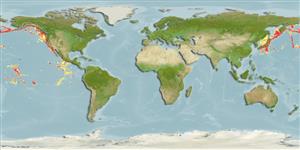分类 / Names
俗名 | 同种异名 | Catalog of Fishes(属, 种) | ITIS | CoL | WoRMS | Cloffa
Elasmobranchii
板鳃亚纲 (鲨鱼与 鱼) (sharks and rays) >
Rajiformes (Skates and rays) >
Arhynchobatidae (Softnose skates)
Etymology: Bathyraja: Greek, bathys = deep + Latin, raja, -ae = a ray (Raja sp) (Ref. 45335); abyssicola: From the Latin 'abyssos' meaning bottomless and 'cola' meaning living at depths; referring to its deep-sea habitat.
More on author: Gilbert.
Environment: milieu / climate zone / depth range / distribution range
生态学
海洋 深海底的; 深度上下限 362 - 2910 m (Ref. 50610). 深水域
North Pacific: Bering Sea; south to the Galapagos Islands, west to Japan.
北太平洋: 日本的太平洋海岸與從加拿大卑詩省到墨西哥。
Length at first maturity / 大小 / 重量 / 年龄
Maturity: Lm ? range ? - 147 cm
Max length : 135 cm TL 雄鱼/尚未辨别雌雄; (Ref. 126515); 157.0 cm TL (female)
简单描述
检索表 | 型态特徵 | 形态测量图
This large, rhomboidal skates (to at least 157 cm TL) have a triangularly shaped disc (width 44.2-63.7% TL), long head length (19.7-27.8% TL), and with rounded pectoral apices; claspers are very long and slender, the tips conspicuously bulbous, large and wide pseudosiphon present, length 20.0% of clasper, with a distinct, curved pseudorhipidion, the inner surface with a defined V-shaped cleft; ventral lobe with a rounded projection; teeth in 27-39 rows on upper jaw, 24-34 rows on lower jaw; pectoral radials 82; pelvic fins 19; total vertebrae 139; the dorsal and ventral surface of disc with prickly dermal denticles and with thorns on dorsal surface of disc, the males with a well-developed alar thorns, no malar thorns, middorsal thorns weak or absent (0-2), the scapulars often none, nuchal thorns strong (2-4), tail thorns moderate (15-30), down the length of tail, interdorsals are weak or obsolete (0-1). Colouration: dorsal dark brown or black-grey, sometimes with small dark blotches scattered on body, the pectoral fin edges are darker than the rest of body, pelvic fins often with whitish anterior tips while ventral is darker than dorsal surface, usually white around the mouth, gills, and cloaca (Ref. 126515).
This species lives in deep waters, on the upper continental slope and often over fine sediment; reported to have a preference for colder temperatures than its congeners. The size at maturity for males is from 109 to 120 cm TL, for females 145 cm TL; size at birth uncertain, with the smallest free-swimming specimen measured 19 cm TL. Feeds on annelids, cephalopods, crabs, shrimps, and bony fishes, the smaller individuals consume more invertebrates (Ref. 126515). Oviparous. Distinct pairing with embrace. Young may tend to follow large objects, such as their mother (Ref. 205). Eggs are oblong capsules with stiff pointed horns at the corners deposited in sandy or muddy flats (Ref. 205). The light golden brown egg cases are large (10.8-11.1 cm TL), with coarse surface due to the rasp-like denticles; with a distinct groove between the lateral keel and the case (absent in all other ENP skate egg cases) and with horns at the corners, the anterior horns more robust than posteriors, with both sets becoming flat and thread-like at tips (Ref. 126515).
卵生的。 明显的成对出现。 幼鱼可能倾向跟随大的个体, 例如他们的母亲.(参考文献 205) 卵为长方形鞘囊具有僵硬的触角沈积在沙滩或泥滩的角落.(参考文献 205) 卵鞘有 105.8 mm 长与 65.2 mm 宽的长。 (参考文献 41249)
Life cycle and mating behavior
成熟度 | 繁殖 | 产卵场 | 卵 | 孕卵数 | 仔鱼
Oviparous, paired eggs are laid. Embryos feed solely on yolk (Ref. 50449). Distinct pairing with embrace. Young may tend to follow large objects, such as their mother (Ref. 205).北太平洋: 日本的太平洋海岸與從加拿大卑詩省到墨西哥。
Knuckey, J.D.S. and D.A. Ebert, 2022. A taxonomic revision of Northeast Pacific softnose skates (Rajiformes: Arhynchobatidae: Bathyraja Ishiyama). Zootaxa 5142(1):1-89. (Ref. 126515)
世界自然保护联盟红皮书 (Ref. 130435: Version 2024-2)
人类利用
工具
特别资料
下载 XML
网络资源
Estimates based on models
Preferred temperature (Ref.
123201): 2.3 - 4.6, mean 2.8 °C (based on 206 cells).
Phylogenetic diversity index (Ref.
82804): PD
50 = 0.5000 [Uniqueness, from 0.5 = low to 2.0 = high].
Bayesian length-weight: a=0.00550 (0.00291 - 0.01038), b=3.13 (2.97 - 3.29), in cm total length, based on LWR estimates for this Genus-body shape (Ref.
93245).
营养阶层 (Ref.
69278): 4.1 ±0.7 se; based on size and trophs of closest relatives
回复力 (Ref.
120179): 低的, 最小族群倍增时间4.5 - 14 年 (Fec assumed to be <100).
Fishing Vulnerability (Ref.
59153): Very high vulnerability (90 of 100).
